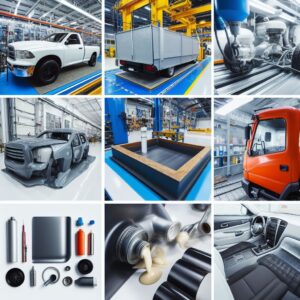Applications of Polyurea in Automotive Manufacturing

Polyurea in Vehicle Maintenance and Repair
Polyurea coatings are increasingly being utilized in the field of vehicle maintenance and repair, offering numerous benefits. This substance is known for its exceptional durability and resistance to abrasion, which makes it ideal for protecting various vehicle parts against wear and tear. Its fast-curing properties are particularly advantageous in this context; polyurea can set and harden in just a few minutes, which is significantly quicker than traditional materials. This rapid curing time is essential in reducing vehicle downtime, allowing for quicker repairs and maintenance processes.
In addition to its quick setting time, polyurea’s versatile application methods make it suitable for a wide range of repair tasks. It can be sprayed, cast, or injected, allowing for precise application in various vehicle components, from undercarriages to engine parts. This versatility also means that polyurea can easily adapt to complex shapes and surfaces, providing a seamless and effective protective layer.
Polyurea’s waterproof and corrosion-resistant properties are highly beneficial in vehicle maintenance. It provides an effective barrier against moisture and chemicals, which can lead to rust and corrosion in vehicle parts. By applying polyurea coatings, the lifespan of these components can be significantly extended, thereby reducing the need for frequent replacements and lowering overall maintenance costs.
The application of polyurea is not limited to external vehicle surfaces. It can also be used internally, for instance, in the lining of fuel tanks or storage compartments. This internal application further enhances the vehicle’s resilience against damaging substances and environmental factors.
The use of polyurea in vehicle maintenance and repair is a testament to its versatility and effectiveness. Its quick curing time, adaptability to various surfaces, and protective qualities make it an invaluable tool in extending the life and improving the performance of vehicles. With its growing popularity, polyurea is set to become a staple in automotive maintenance and repair strategies, offering efficient and cost-effective solutions for a wide range of vehicular challenges.
Innovation and Future Trends
The role of polyurea in the automotive industry is rapidly evolving, particularly as the sector shifts towards more advanced and sustainable technologies. As an innovative material, polyurea is finding new applications in cutting-edge automotive developments, particularly in the realms of electric vehicles (EVs) and autonomous vehicles.
Polyurea is being explored for its potential in battery insulation. EV batteries require robust protection against various environmental factors, as well as effective thermal management to maintain optimal performance. Polyurea’s insulating properties can play a crucial role in this aspect. It can help in managing the battery’s temperature, protecting it from extreme temperatures that could affect its efficiency and lifespan. The material’s resistance to chemicals and moisture adds an extra layer of safety, reducing the risk of battery damage due to leaks or chemical exposure.
For autonomous vehicles, polyurea’s application extends to the protection of sensitive sensors and electronic components. These vehicles rely heavily on an array of sensors for navigation and safety, and these components must be shielded from environmental damage, such as moisture, dust, and impact. Polyurea coatings can provide a durable, weather-resistant barrier that ensures the long-term functionality of these critical components. This application is particularly important as the industry moves towards increased automation and reliance on sophisticated technology.
The adaptability of polyurea to various automotive technologies presents exciting prospects for future vehicle designs. Its versatility allows it to be used in a multitude of ways, from enhancing the structural integrity of vehicles to contributing to the overall sustainability of automotive manufacturing processes. As vehicles become more technologically advanced and environmentally friendly, polyurea stands as a material that canadapt to these changes and also enhance the performance and durability of future automotive innovations. Its role in the automotive industry is expected to grow and diversify, paralleling the evolution of vehicle technology and design.
